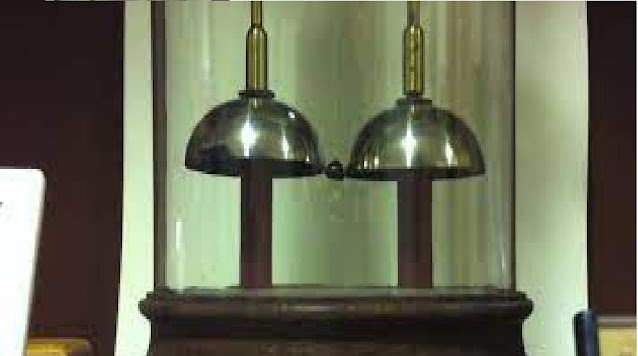There sits, in the Clarendon Laboratory at Oxford University, a bell that has been ringing, nonstop, for at least 175 years. It's powered by a single battery that was installed in 1840. Researchers would love to know what the battery is made of, but they are afraid that opening the bell would ruin an experiment to see how long it will last.
The bell's clapper oscillates back and forth constantly and quickly, meaning the Oxford Electric Bell, as it's called, has rung roughly 10 billion times, according to the university. It's made of what's called a "dry pile," which is one of the first electric batteries. Dry piles were invented by a guy named Giuseppe Zamboni (no relation to the ice resurfacing company) in the early 1800s. They use alternating discs of silver, zinc, sulfur, and other materials to generate low currents of electricity.
Piles similar to this were made by Zamboni, whose batteries were constituted of about 2,000 pairs of discs of tin foil glued to paper impregnated with zinc sulphate and coated on the other side with manganese dioxide."
The bell didn't necessarily start as an experiment. It was manufactured by London instrument makers Watkin and Hill, and has a handwritten note that says "set up in 1840" displayed alongside it. It was eventually purchased by a researcher, who continued to allow it to ring (Oxford University suggests there's evidence that it may have actually been set up as early as 1825). The Guinness Book of World Records has named its power source the "world's most durable battery."
Instead, the clapper oscillates back and forth between the bell constantly, which you can see happening in this video. At this point, the experiment is more of a curiosity than anything—Croft says that the battery pulls 1 nanoAmp each time it oscillates between the bell's sides, which is an exceedingly low amount of current.In other words, at this point, we're probably not going to build a better battery thanks to this experiment.
The bell hasn't always been merely a curiosity: In World War II, infrared telescopes were powered using similar dry pile batteries, because a portable, low-current electricity source was necessary. Croft wrote that an Oxford physicist, inspired by the bell, looked up a recipe for a similar battery from the era to power the telescopes. So, the bell rings and rings and rings—no one is sure when it's going to stop. In fact, Croft theorizes that "the clapper seems more likely to wear out than the electro-chemical energy." At that point, we might finally learn what's been powering the thing.







No comments:
Post a Comment